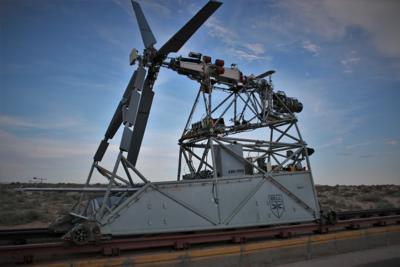Sat, Sep 16, 2023
The Past and Future of High-Speed Flight
Bell Textron Inc. has delivered a High-Speed Vertical Takeoff and Landing (HSVTOL) test-article to Holloman Air Force Base for demonstration and technology evaluation. Testing teams will leverage the Arnold Engineering Development Complex Holloman High Speed Test Track for purpose of vetting the test-article’s folding-rotor, integrated-propulsion, and flight control technologies at speeds representative of actual flight.

Bell executive vice-president of engineering Jason Hurst stated: “The HSVTOL test-article delivery and start of sled-testing operations serves as a major milestone in our mission to develop the next generation of high-speed vertical lift aircraft. Bell plans to showcase HSVTOL technology informed by more than 85-years of high-speed rotorcraft development and leverage lessons learned to produce a flying prototype with game-changing capabilities.”
Bell, by dint of the forthcoming sled-test regimen, seeks to validate key technologies by way of a full-scale, integrated demonstration in a representative operating environment. Bell plans for the test-article to execute a series of HSVTOL high-speed transition maneuvers—a first-of-its-kind capability for vertical lift aircraft. Prior to the HSVTOL test-article’s delivery to Holloman Air Force Base, Bell successfully completed functional demonstrations of the contraption at the company’s Flight Research Center.

Bell’s High-Speed Vertical Takeoff and Landing (HSVTOL) technology amalgamates the hover capability of a conventional helicopter with the speed (four-hundred-plus-knots), range, and survivability of a fixed-wing jet aircraft. Bell has developed high-speed vertical lift technology for more than 85-years, pioneering innovative VTOL configurations such as the X-14, X-22, XV-3, and XV-15 for customers the likes of NASA, the U.S. Army. and U.S. Air Force. The antecedent vehicles build on Bell’s proven history of high-speed flight, which extends back to the Bell X-1—the storied rocket-powered experimental aircraft in which then Captain Charles “Chuck” Yeager made the world’s first manned supersonic flight on 14 October 1947.
More News
Convective SIGMET A weather advisory concerning convective weather significant to the safety of all aircraft. Convective SIGMETs are issued for tornadoes, lines of thunderstorms, e>[...]
Aero Linx: United Flying Octogenarians WELCOME to a most extraordinary group of aviators, the United Flying Octogenarians (UFO). Founded in 1982 with just a handful of pilots, we h>[...]
Pilot’s Decision To Attempt Takeoff With Frost Covering The Airplane’s Wings Analysis: The pilot of the light sport airplane was preparing to depart for a cross-country>[...]
“We’ve paid for the cable line’s repair for the customer and have apologized for the inconvenience this caused them...” Source: Some followup info from an A>[...]
Coupled Approach An instrument approach performed by the aircraft autopilot, and/or visually depicted on the flight director, which is receiving position information and/or steerin>[...]
 ANN's Daily Aero-Term (12.01.25): Convective SIGMET
ANN's Daily Aero-Term (12.01.25): Convective SIGMET ANN's Daily Aero-Linx (12.01.25)
ANN's Daily Aero-Linx (12.01.25) NTSB Final Report: Remos Aircraft GmbH Remos GX
NTSB Final Report: Remos Aircraft GmbH Remos GX Aero-News: Quote of the Day (12.02.25)
Aero-News: Quote of the Day (12.02.25) ANN's Daily Aero-Term (12.02.25): Coupled Approach
ANN's Daily Aero-Term (12.02.25): Coupled Approach




